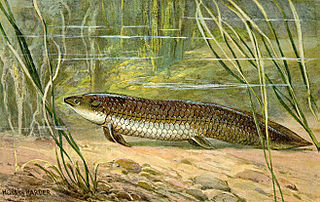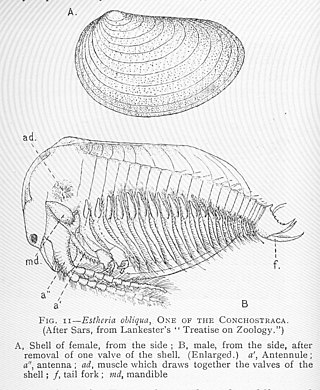
Enchodus is an extinct genus of aulopiform ray-finned fish related to lancetfish and lizardfish. Species of Enchodus flourished during the Late Cretaceous, and there is some evidence that they may have survived to the Paleocene or Eocene; however, this may just represent reworked Cretaceous material.

Weald Clay or the Weald Clay Formation is a Lower Cretaceous sedimentary rock unit underlying areas of South East England, between the North and South Downs, in an area called the Weald Basin. It is the uppermost unit of the Wealden Group of rocks within the Weald Basin, and the upper portion of the unit is equivalent in age to the exposed portion of the Wessex Formation on the Isle of Wight. It predominantly consists of thinly bedded mudstone. The un-weathered form is blue/grey, and the yellow/orange is the weathered form, it is used in brickmaking.

Ceratodus is an extinct genus of lungfish. It has been described as a "catch all", and a "form genus" used to refer to the remains of a variety of lungfish belonging to the extinct family Ceratodontidae. Fossil evidence dates back to the Early Triassic. A wide range of fossil species from different time periods have been found around the world in places such as the United States, Argentina, Greenland, England, Germany, Egypt, Madagascar, China, and Australia. Ceratodus is believed to have become extinct sometime around the beginning of the Eocene Epoch.
Hyposaurus is a genus of extinct marine dyrosaurid crocodyliform. Fossils have been found in Paleocene aged rocks of the Iullemmeden Basin in West Africa, Campanian–Maastrichtian Shendi Formation of Sudan and Maastrichtian through Danian strata in New Jersey, Alabama and South Carolina. Isolated teeth comparable to Hyposaurus have also been found in Thanetian strata of Virginia. It was related to Dyrosaurus. The priority of the species H. rogersii has been debated, however there is no sound basis for the recognition of more than one species from North America. The other North American species are therefore considered nomina vana.
Igdabatis is a prehistoric genus of ray whose fossils are found in rocks dating from the Maastrichtian stage of Spain, the Dukamaje Formation of Niger and the Takli, Lameta, Fatehgarh and Intertrappean Beds Formations of India.

Ischyrhiza is an extinct genus of sclerorhynchoid ray from the Late Cretaceous (Cenomanian-Maastrichtian).
Ferganoceratodus is a genus of prehistoric lungfish known from the Mesozoic of Asia. Based on morphological evidence, it has either been recovered as a basal member of the Ceratodontiformes or to be the sister group of the Neoceratodontidae.
The North American land mammal ages (NALMA) establishes a geologic timescale for North American fauna beginning during the Late Cretaceous and continuing through to the present. These periods are referred to as ages or intervals and were established using geographic place names where fossil materials were obtained.

Odontaspis and Greek: ἀσπίς aspís 'shield') is a genus of sand shark with two extant species.
Wintonopus is an ichnogenus of dinosaur footprint. Its footprints have been found at Lark Quarry in Queensland Australia. The genus is named after the Winton Formation in which the tracks were found. Other tracks were found in the Broome Sandstone of Dampier Peninsula, Western Australia.

Sinemydidae is an extinct family of turtles from Cretaceous to Paleocene deposits in Asia and North America. Their exact position is engimatic, they have alternatively been considered stem-group cryptodires, but also "crownward stem-turtles" alongside Macrobaenidae, Paracryptodira, Xinjiangchelyidae, Thalassochelydia and Sandownidae outside of crown Testudines.

Lioestheria is an extinct genus of clam shrimp that thrived from the Carboniferous to the Cretaceous. They fed on detritus, being very small slow moving, nektonic organisms that filter fed as they floated. They have been found in both marine and freshwater environments.

Leyvachelys is an extinct genus of turtles in the family Sandownidae from the Early Cretaceous of the present-day Altiplano Cundiboyacense, Eastern Ranges, Colombian Andes. The genus is known only from its type species, Leyvachelys cipadi, described in 2015 by Colombian paleontologist Edwin Cadena. Fossils of Leyvachelys have been found in the fossiliferous Paja Formation, close to Villa de Leyva, Boyacá, after which the genus is named. The holotype specimen is the oldest and most complete sandownid turtle found to date.
Plicatoscyllium is an extinct genus of orectolobiform shark known from deposits of Late Cretaceous age in France, Jordan, the Netherlands, Syria and the United States. Remains tentatively referrable to the genus from Cenozoic deposits have been discovered in Saudi Arabia.

Peramus is an extinct genus of cladotherian mammal. It lived in the Late Jurassic and Early Cretaceous of Europe and North Africa.
Protolamna is an extinct genus of mackerel shark from the Cretaceous Period. The genus is known from Europe, Asia and North America.
Ankistrorhynchus is an extinct genus of sawfish-like ray from the Cretaceous Period. It is known only isolated rostral teeth from two species. A. lonzeensis is named for its type locality of Lonzée, Belgium. It is from the lower Santonian stage. A. washakiensis was described from the Campanian-aged Mesaverde Formation of Wyoming, USA. The species A. major was named from Campanian/Santonian of New Jersey, USA off of fragmentary material, thus making its validity questionable.
Arenila is an extinct genus of bothremydid pleurodiran turtle that was discovered in the Western Desert of Egypt. The genus consists solely of type species A. krebsi.
Llanosuchus is an extinct genus of notosuchian mesoeucrocodylian known from the Late Cretaceous Los Llanos Formation in Argentina. It contains a single species, L. tamaensis.








